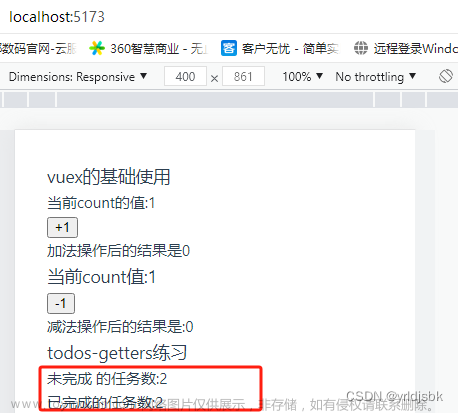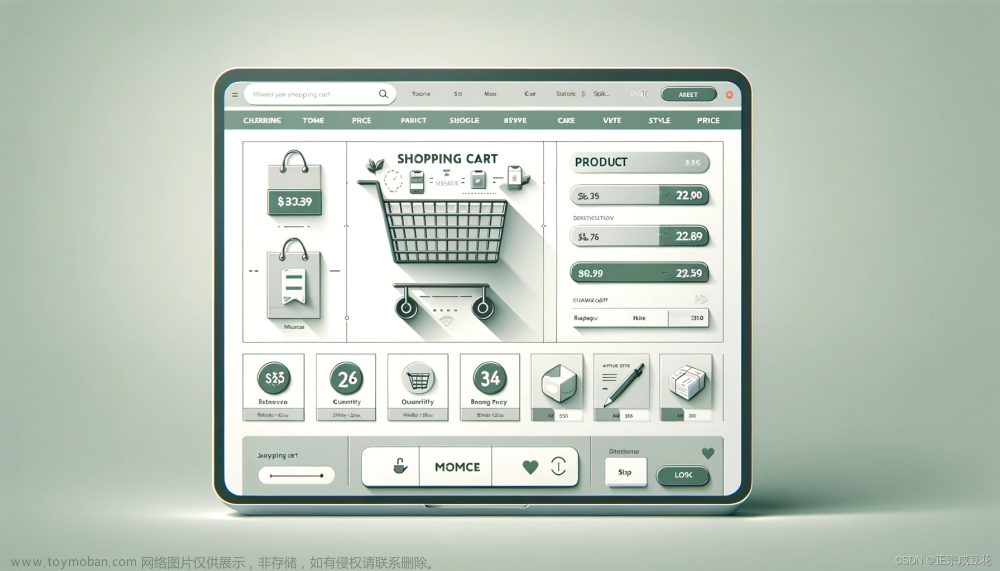前提步骤:
1、 搭建一个vue2项目
2、 修改App.vue文件;修改App.vue组件里面引入的子组件内容(在src文件夹下新建pages文件夹,新建index.vue页面,以供使用);
正式开始vuex的相关操作:
一、安装vuex:
npm install vuex --save
注意,以上的命令安装的会是最新版本的。如果没有指定版本,npm会默认获取最新版本。但是vue2.0只能安装vuex3.x版本,最高3.6.2,vue3.0才能装vuex4.x版本。因此如果是vue2项目要指定版本:
npm install vuex@3.6.2 --save
二、项目配置VUEX:
项目src目录下创建store目录,并在store下创建index.js,初始化Vuex。
Store文件夹中主要js如下:
三、创建相关文件:
1、state
概念:
state:存储应用状态数据的对象,与vue中data类似
步骤:
(1)比如创建state.js文件的内容如下:
export default {
state1: "状态1"
}
(2)在store文件夹下的index.js文件下引入:
import Vue from 'vue'
import Vuex from 'vuex'
Vue.use(Vuex)
import state from '@/store/state.js'
const store = new Vuex.Store({
// 用来存入状态
state: state
})
export default store
(3)接下来,将store挂载到vue实例中,在src文件夹下的main.js文件中添加:
…
import store from './store'
new Vue({
…
store,
}).$mount('#app')
最后代码呈现如下:
(4)在组件中使用vuex。可直接使用或者使用辅助函数
1>直接使用:this.$store.state.xxx
<template>
<div>
状态数据1:{{this.$store.state.state1}}
</div>
</template>
2>使用辅助函数:mapState
<template>
<div>
状态数据1:{{state1}}
</div>
</template>
<script>
import { mapState } from 'vuex'
export default {
computed:{
...mapState(['state1']) // 使用对象展开运算符将此对象混入到外部对象中
}
// 没使用对象展开运算符的写法为:
// computed: mapState(['state1'])
}
</script>
2、getters
概念:
getters: 类似vue的计算属性,store中数据的变化,getters的数据也会发生变化
步骤:
(1)创建getters.js文件内容可如下:
export default {
numSum:(state)=>{
var sum=0;
for(var i=0; i<state.numbers.length; i++){
sum +=state.numbers[i]
}
return sum;
}
}
(2)在store文件夹下的index.js文件下引入(参照引入state.js)
(3)将store挂载到vue实例中(state已经实现了这步操作)
(4)在组件中使用(参考state里面数据的使用,使用辅助函数mapGetters也类似)
3、mutations
概念:
mutations: 提交mutation来修改store中的状态,同步操作
步骤:
(1)创建mutations.js文件内容可如下:
export default {
mutEditStat1(state){
state.state1 = '状态111改变了'
}
}
(2)在store文件夹下的index.js文件下引入(参照引入state.js)
(3)将store挂载到vue实例中(state已经实现了这步操作)
(4)在组件中使用:
1>直接使用:
<template>
<div>
{{state1}}
<button @click="update1()">点击改变状态</button>
</div>
</template>
<script>
export default {
methods: {
update1(){
this.$store.commit('mutEditStat1') // 唤醒一个 mutation 处理函数mutEditStat1
}
}
}
</script>
2>使用mapMutations辅助函数:
<template>
<div>
{{state1}}
<button @click="update1()">点击改变状态</button>
</div>
</template>
<script>
import { mapMutations } from 'vuex'
export default {
methods: {
...mapMutations(['mutEditStat1']),
update1(){
this.mutEditStat1()
}
}
}
</script>
若带有参数,
Mutations文件内容可如下:
export default {
mutEditStat2(state,req){
state.state2="状态2" + req;
}
}
其它内容和无参数的内容一样,只是在用的时候传参:
update3(){
this.mutEditStat2('传参过来的')
}
4、actions
概念:
actions:与mutations类似,提交修改state的行为,处理异步任务(提交的是mutation,不是直接修改状态)
步骤:
(1)创建ations.js文件内容可如下:
export default {
actEditStat1(context){
setTimeout(()=>{
context.commit("mutEditStat1")
}, 3000) //我们此时就可以在 action 内部执行异步操作了,解决mutation 必须同步执行的问题
}
// 带参数
actEditStat1(context,num){
setTimeout(()=>{
context.commit("mutEditStat1")
}, 3000)
console.log(num)
}
}
(2)在store文件夹下的index.js文件下引入(参照引入state.js)
(3)将store挂载到vue实例中(state已经实现了这步操作)
(4)在组件中使用:
1>直接使用:
<template>
<div>
{{state1}}
<button @click="update()">actions提交mutation更新状态</button>
</div>
</template>
<script>
export default {
methods: {
update(){
this.$store.dispatch('actEditStat1') //分发 Action。Action 通过 store.dispatch 方法触发
// 若是带参数:
// this.$store.dispatch('actEditStat1',22)
}
}
}
</script>
使用mapActions辅助函数:
<template>
<div>
{{state1}}
<button @click="update1()">点击改变状态</button>
</div>
</template>
<script>
import { mapActions } from 'vuex'
export default {
methods: {
...mapActions(['actEditStat1']), // `this.mutEditStat1()` 映射为 `this.$store.commit('mutEditStat1')`
update1(){
this.actEditStat1()
}
}
}
</script>
注意: mutation 必须是同步函数
辅助函数总结:
mapState和mapGetters写在computed中,mapMutations和mapActions写在methods中
5、modules
概念:
modules:模块化状态管理,为了开发大型项目,方便状态管理而使用的
使用后目录大概如下:
模块内内容没变化,主要需要修改的index.js文件内容:
import Vue from 'vue'
import Vuex from 'vuex'
Vue.use(Vuex)
import userInfo from '@/store/modules/userInfo.js'
import shopCart from '@/store/modules/shopCart.js'
export default new Vuex.Store({
state: {},
getters: {},
mutations: {},
actions: {},
modules:{
userInfo,
shopCart
}
})
shopCart.js文件内容:
import state from '@/store/modules/shopCart/state.js'
import getters from '@/store/modules/shopCart/getters.js'
import mutations from '@/store/modules/shopCart/mutations.js'
import actions from '@/store/modules/shopCart/actions.js'
export default {
namespaced: true, //开启命名空间
state:state,
getters: getters,
mutations: mutations,
actions: actions
}
userInfo.js文件内容类似。自行修改。
组件中使用示例1:
export default {
methods: {
login(){
if(this.$store.state.userInfo.isLogin){ // modules中直接使用state: this.$store.state.模块名.xxx;
this.$store.commit('userInfo/logout'); // modules中直接使用mutations:this.$store.commit('模块名/mutation名', 参数);
}else{
this.$store.commit('userInfo/login');
}
}
},
}
示例2:文章来源:https://www.toymoban.com/news/detail-730935.html
computed:{
// modules中使用mapState辅助函数:
// computed: {
// ...mapState('模块名', ['xxx']),
// ...mapState('模块名', {'新名字': 'xxx'})
// }
...mapState({
userInfo:state=>state.userInfo
})
},
示例3:文章来源地址https://www.toymoban.com/news/detail-730935.html
computed:{
// modules中使用mapGetters辅助函数:
// computed: {
// ...mapGetters('模块名', ['xxx']),
// ...mapGetters('模块名', {'新名字': 'xxx'})
// }
...mapGetters("shopCart", { // 对象形式
countGoods: "countGoods"
}),
},
到了这里,关于二、怎么简单使用vuex的文章就介绍完了。如果您还想了解更多内容,请在右上角搜索TOY模板网以前的文章或继续浏览下面的相关文章,希望大家以后多多支持TOY模板网!











